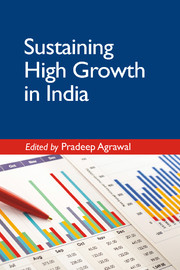Book contents
- Frontmatter
- Contents
- List of Tables
- List of Graphs and Maps
- Preface
- Introduction
- Section 1 Ensuring Macroeconomic Stability for Sustaining High Growth Rates
- Section 2 Promoting Industrial Development for Sustaining High Growth Rates
- Section 3 The International Economic Issues and Sustaining High Growth
- Section 4 Infrastructure Bottlenecks to Sustaining High Growth
- Section 5 Some Socio-political Issues in Sustaining High Growth
- 13 Demographic Dividend and Economic Growth in India and China
- 14 Does Social Cohesion Limit Uncertainties in Economic Growth? A Pre-and Post-reform Analysis from India
- 15 Does Openness and Democracy Reduce Corruption? Results for South Asian Nations and India
- 16 Regional Dynamics of Rural Credit and Growth in India: Exploring Nonlinearity and Convergence in Growth Patterns
- List of Contributors
- Obituary
- Index
13 - Demographic Dividend and Economic Growth in India and China
from Section 5 - Some Socio-political Issues in Sustaining High Growth
Published online by Cambridge University Press: 08 February 2018
- Frontmatter
- Contents
- List of Tables
- List of Graphs and Maps
- Preface
- Introduction
- Section 1 Ensuring Macroeconomic Stability for Sustaining High Growth Rates
- Section 2 Promoting Industrial Development for Sustaining High Growth Rates
- Section 3 The International Economic Issues and Sustaining High Growth
- Section 4 Infrastructure Bottlenecks to Sustaining High Growth
- Section 5 Some Socio-political Issues in Sustaining High Growth
- 13 Demographic Dividend and Economic Growth in India and China
- 14 Does Social Cohesion Limit Uncertainties in Economic Growth? A Pre-and Post-reform Analysis from India
- 15 Does Openness and Democracy Reduce Corruption? Results for South Asian Nations and India
- 16 Regional Dynamics of Rural Credit and Growth in India: Exploring Nonlinearity and Convergence in Growth Patterns
- List of Contributors
- Obituary
- Index
Summary
INTRODUCTION
Demographic transition is a process involving the transition from a young-aged population structure (high birth and death rates) to an old-aged population structure (low birth and death rates). Such shifts in population age structure have significant developmental implications for large and populous countries like India and China. With demographic transition, there is an increase in the share of working-age population, which subsequently lowers the dependency ratio (dependents to working-age population) and allows for acceleration in economic growth. Hence, the net growth benefits derived from an increased share of working-age population due to demographic transition is referred to as the demographic dividend (Gribble and Bremner, 2012).
The Chinese economy witnessed unparalleled economic growth during the transition phase. However, the demographic process will now contribute to the faster ageing of the Chinese population. Interestingly, India is currently in a phase where the population is relatively young, and it will witness continual decline in the share of dependents (children and elderly). This also provides an opportunity to harness the demographic dividend.
It should be emphasized that the notion of demographic dividend is not necessarily based on the concept of labour abundance (which India and China have), but is related essentially to the share of working-age population in total population and the nature of dependency profile. An economy with lower dependency burden will present itself with higher chances of economic growth, largely because a lower dependency burden allows for higher savings and investment in physical and human capital, contributing to sustained economic growth. In fact, it is estimated that nearly one-third of the economic miracle of East Asian countries (including China) can be attributed to the demographic dividend (Bloom and Williamson, 1998; Bloom and Finley, 2009). Similarly, other cross-country studies have observed a positive association between age-structure transition and economic growth (Behrman et al., 1999; Andersson, 2001; Bloom et al., 2003; Feng and Mason, 2005; Kelley and Schmidt, 2005; Bloom et al., 2006; Choudhry and Elhorst, 2010; Wei and Hao, 2010). Also, capital deepening and prudent fiscal management can ensure sustained developmental process when the phase of demographic dividend comes to an end (Mason and Lee, 2006).
- Type
- Chapter
- Information
- Sustaining High Growth in India , pp. 391 - 416Publisher: Cambridge University PressPrint publication year: 2017



